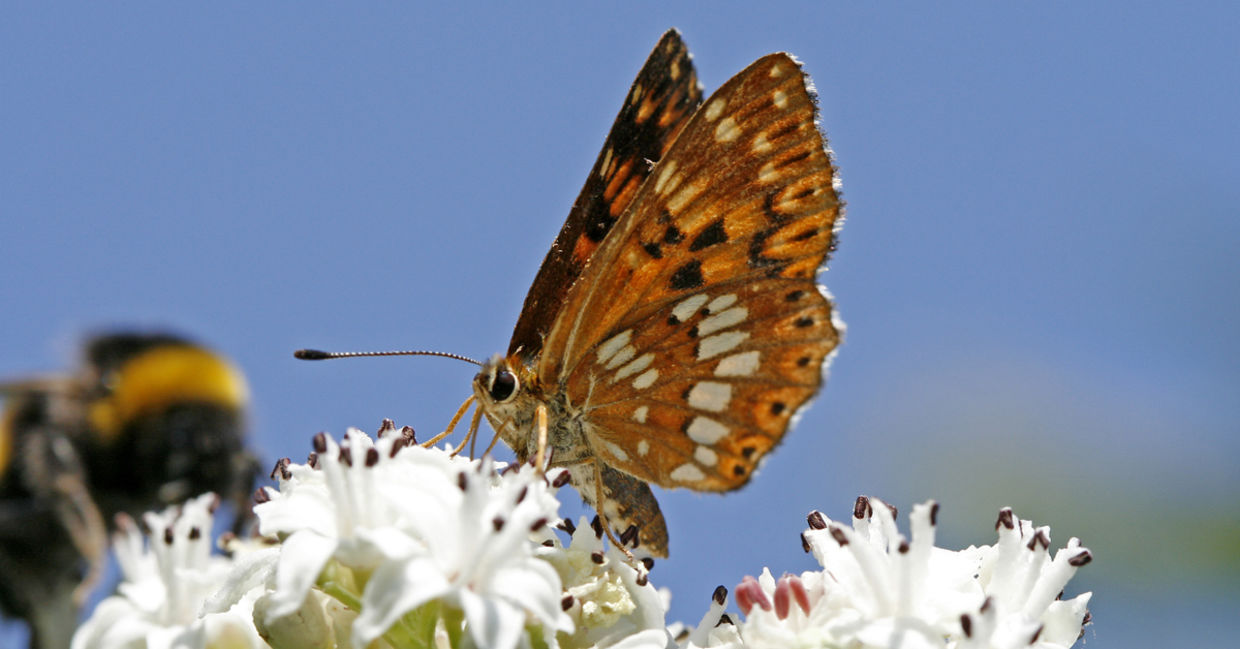
(Shutterschock / Shutterstock.com)
A tiny amber insect hardly bigger than a thumbnail, it’s unlikely that you’d spot the Duke of Burgundy butterfly at first glance. A rare species found only in England, “the duke” butterfly requires very specific conditions to thrive — it’s only happy in scrubby grassland and woodland clearings. After decades of plunging numbers, this once-endangered creature is now making a soaring comeback, thanks to a wildly successful conservation campaign.
According to the United Kingdom Butterfly Monitoring Scheme, the Duke of Burgundy’s population has spiked by some 25 percent over the last 10 years, a tremendous return to almost normalcy after its near-extinction. Experts hail the Burgundy baby boom as a conservation success story.
I see your marbled white, and raise you a Duke of Burgundy pic.twitter.com/O7fpaQcw4c
— John Ingham (@Johnpingham) June 19, 2021
“This is a species that has come back from the brink,” Dan Hoare, Director of Butterfly Conservation, told The Guardian. “We’ve halted the slide towards extinction and in some landscapes it is genuinely marching back across the landscape. That’s a real cause for celebration.”
Hoare served as one of the chief architects of the duke’s rescue campaign, having researched the causes of the butterfly’s population drop. He discovered that “over management” of grassland was the surprising reason 27 percent of the butterflies disappeared from an area where they were once a stable presence.
Oftentimes, environmental protection grants lead to well-meaning intensive brush clearings of land, aimed at preserving flowers targeted for conservation. While the clearing away of shrubbery has helped the flowers thrive, it destroyed the natural habitat of the butterflies.
“The duke doesn’t like the way our conservation effort is funded, with grants awarded every 10 years to remove all scrub in one go,” Hoare explained. “That’s disastrous — Dukes want scrub removal little and often.”
After determining that a lack of shrubbery was one of the main culprits behind the dukes’ disappearance, Butterfly Conservation worked to connect areas of shrubbery to recently cleared areas, creating “corridors” aimed at luring the butterflies back. The organization also reached out to locals in North Yorkshire, the dukes’ traditional stomping ground, to track the creatures.
The efforts of farmer John Hiscock to support #nature on his #farm has led to the discovery of Britain's largest colony of #endangered Duke of Burgundy #butterflies on his #farmland. Mr Hiscock supplies dairy to Duchy Organics. #organic #wildlife https://t.co/EdtKiJWRdD pic.twitter.com/PimXZ7Golc
— Nourish the planet (@nourish_planet) June 18, 2021
Local farmers embracing more eco-friendly agriculture are also cited as a reason for the butterfly’s return. Dairy farmer John Hiscock’s land contains one of the biggest colonies of these butterflies, and it’s likely due to his green farming techniques. He is a supplier to the Duchy brand at popular supermarket Waitrose, which has branches all over the UK.
“We have farmed organically for more than 20 years, with no pesticides, sprays or chemical fertilizers, allowing the wildlife habitat to improve and these rare butterflies to thrive along with many other species,” he told The Guardian.
The story of the dukes’ glorious population boom illustrates the importance of big-picture, holistic conservation efforts. While it’s tempting for environmental activists to zero in on saving a particular species, it’s important to remember that ecosystems contain rich, complex relationships between a variety of plants and creatures.
Even small changes can disrupt nature’s delicate balance. Dramatic moves, such as major brush clearing, can only be made after considering the needs of all the species in an area. On that same note, farmers must also adopt sustainable agricultural practices that are better for both the Earth and the living creatures on their farmland.
As recent years have seen increased awareness around conservation, the success story of the Duke of Burgundy proves that people have the power to save a species. By involving stakeholders from the surrounding area — from locals willing to help track and count the butterflies, to farmers, and regional NGOs — proper conservation is very much a community effort. Working together and pooling resources for the greater good is the only way to rescue species from the brink of extinction, and ensure that future generations will enjoy the beauty of nature for years to come.
YOU MIGHT ALSO LIKE:
Found in Florida: A Blue Bee Thought to be Extinct!
Meet the Giant Sandcastle Built for Britain’s Smallest Swallows
Once Extinct, An Enigmatic Butterfly Returns to England







